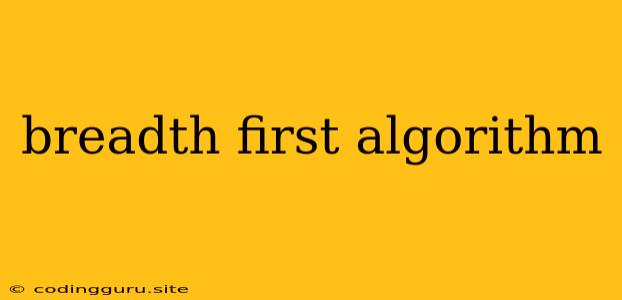What is the Breadth-First Search Algorithm?
The breadth-first search (BFS) algorithm is a fundamental graph traversal algorithm that systematically explores all the vertices of a graph level by level. It starts from a given source vertex and visits all its neighbors first, then visits their neighbors, and so on, until all reachable vertices have been explored.
Think of it like exploring a maze. You start at the entrance and visit all the rooms directly connected to the entrance. Then, you move on to the rooms connected to those rooms and so forth. You keep expanding outward from the starting point, covering every room in the maze until you've found your way to the exit or have explored all possible paths.
How does the Breadth-First Search Algorithm work?
The BFS algorithm works by using a queue data structure. Here's a step-by-step breakdown:
-
Initialization:
- Start by marking the source vertex as visited.
- Add the source vertex to the queue.
-
Iteration:
- While the queue is not empty:
- Dequeue a vertex from the front of the queue.
- For each unvisited neighbor of the dequeued vertex:
- Mark the neighbor as visited.
- Enqueue the neighbor.
- While the queue is not empty:
-
Termination:
- The algorithm terminates when the queue is empty, meaning all reachable vertices have been visited.
Example
Let's consider a simple example of a graph:
A
/ \
B --- C
\ /
D
If we start the BFS algorithm at vertex A, here's how it would proceed:
-
Initialization:
- Mark A as visited.
- Add A to the queue: [A]
-
Iteration 1:
- Dequeue A: [ ]
- Visit B and C, and add them to the queue: [B, C]
-
Iteration 2:
- Dequeue B: [C]
- Visit D, and add it to the queue: [C, D]
-
Iteration 3:
- Dequeue C: [D]
- No unvisited neighbors.
-
Iteration 4:
- Dequeue D: [ ]
- No unvisited neighbors.
The queue is now empty, and all reachable vertices have been visited. The order of visits would be A, B, C, D.
Advantages of Breadth-First Search
- Finds the shortest path: BFS can be used to find the shortest path between two vertices in a graph.
- Simple to implement: BFS is relatively straightforward to implement compared to other graph traversal algorithms.
- Suitable for unweighted graphs: BFS is particularly efficient for finding shortest paths in unweighted graphs where all edges have the same cost.
Disadvantages of Breadth-First Search
- Can be inefficient for large graphs: BFS can consume a significant amount of memory for large graphs because it stores all the visited vertices in the queue.
- Not optimal for weighted graphs: BFS does not consider the edge weights and might not find the shortest path in a weighted graph.
Use Cases of Breadth-First Search
- Shortest path problems: Finding the shortest path between two vertices in a network.
- Network exploration: Traversing a network to discover all reachable nodes.
- Web crawling: Exploring the links on a website to find relevant pages.
- Game AI: Pathfinding for characters in games.
Conclusion
The breadth-first search (BFS) algorithm is a powerful and versatile graph traversal algorithm. It finds the shortest paths in unweighted graphs and is particularly efficient for exploring network structures. Its simplicity and wide applicability make it a valuable tool for solving various problems in computer science and other fields.
